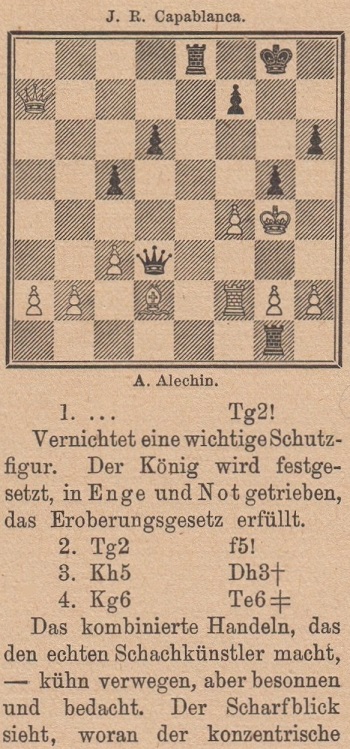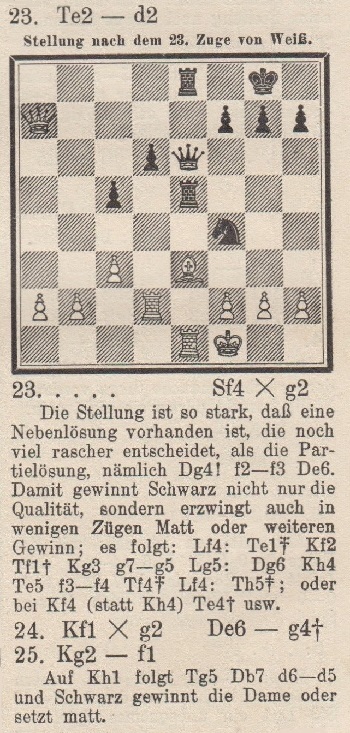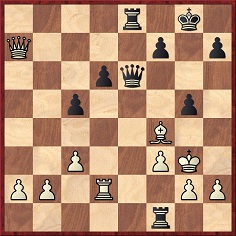
Edward Winter
On pages 63-64 of Turnierpraxis (Berlin and Leipzig, 1922) Franz Gutmayer gave the following:


Thus Gutmayer claimed that the position arose in a game (undated) between Alekhine and Capablanca, and that play continued: 1...Rxg2+ 2 Rxg2 f5+ 3 Kh5 Qh3+ 4 Kg6 Re6 mate.
We know of no such game.
(1973)
From Jan Kalendovský (Brno, Czech Republic) comes a proposed solution to the puzzle.
In his sixth-round victory over Alekhine at St Petersburg, 1914, Capablanca won with the sacrificial combination 23...Nxg2. On page 65 of the tournament book ...

... Tarrasch preferred 23...Qg4 24 f3 Qe6 25 Bxf4 Rxe1+ 26 Kf2 Rf1+ 27 Kg3 g5

28 Bxg5 Qg6 29 Kh4 (or 29 Kf4 Re4+, etc.) 29...Re5 30 f4 Rxf4+ 31Bxf4 Rh5 mate.
The diagrammed position (arising after move 27 in the Tarrasch variation) broadly resembles that given in C.N. 1973.
(1988)
Stephen Berry (London) has ingeniously concocted a variation (after 23...Qg4 24 f3 Qe6 25 Bxf4 Rxe1+ 26 Kf2) which results in Gutmayer's position: 26...Rg1 (threat: 27...Qe1 mate) 27 Kg3 h6 28 Rf2 (28 Rxd6 Qe2) 28...g5 29 Bd2 Qc4 (intending 30...Qh4 mate) 30 f4 Qd3+ 31 Kg4.
(2003)
Peter Anderberg (Harmstorf, Germany) has now found that the line created by Stephen Berry was pointed out by C. Sander on page 170 of the June 1914 Deutsche Schachzeitung.
We add that when Gutmayer gave the position (i.e. the first diagram above) in another of his books, Der fertige Schach-Praktiker (Leipzig, 1921, page 65 and Leipzig, 1923, page 39), he stated that the position was a ‘variation’, a clarification which was absent from Turnierpraxis.
For the record, below is the full note regarding Sander in the June 1914 Deutsche Schachzeitung:

‘Herr C. Sander in Leipzig teilt uns mit, dass statt dieses hübschen Opfers [23…Sxg2] folgende Fortsetzung weit stärker gewesen wäre: 23…Dg4 24 f3! De6! 25 Lxf4! Txe1+ 26 Kf2 Tg1! 27 Kg3! h6 und [Weiss] ist unrettbar verloren. Auf 28 h4 entscheidet De1+ nebst Th1, auf 28 Txd6 aber De2 und auf 28 Lxd6 Dg6+. Nach 28 Tf2 g5 29 Ld2 folgt Dc4 30 f4 Dd3+ 31 Kg4 und Schwarz erzwingt in vier Zügen Matt: 31…Txg2+ 32 Txg2 f5+ usw.’
Yet it is to Tarrasch, not Sander, that posterity has attributed the purportedly faster winning line 23…Qg4 (see, for instance, Reinfeld’s annotations in The Immortal Games of Capablanca).
Has an injustice occurred or did Tarrasch also publish annotations to the game in a newspaper or magazine in spring, 1914, i.e. before the appearance of his tournament book?
(3300)
This matter was summarized in C.N. 11193, an item written on 20 January 2019, shortly after the death of our correspondent Stephen Berry.
Latest update: 6 March 2025.
To the Chess Notes main page.
To the Archives for other feature articles.
Copyright: Edward Winter. All rights reserved.